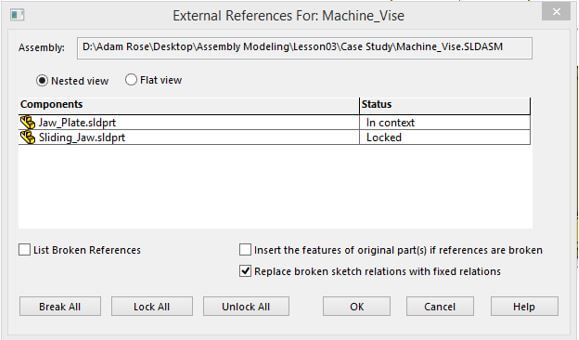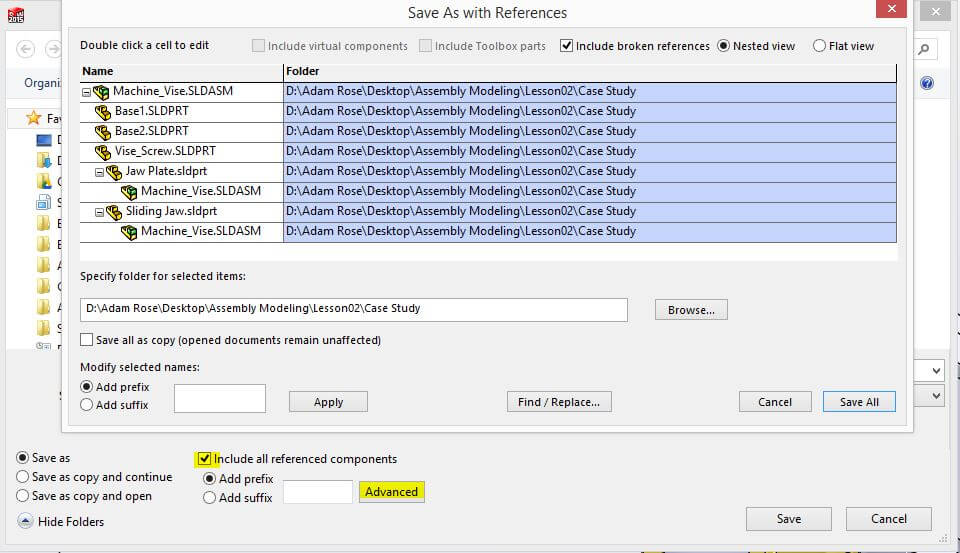SOLIDWORKS allows models to be created with links from one file to another, allowing updates in geometry from one file to propagate between documents. These links are called an “external reference” and the most common way to create these is by modelling within the context of an assembly. The references are usually nothing more than sketch relations.
Once created these links can be very easy to lose or break in some way, so there are some best practices involved which should alleviate the small issues you may experience from time to time.
During the normal modelling process you may occasionally see reference symbols next to a file, these symbols give an indication of the state of the file references, they are listed below:
• Out of context is shown as ->?, This usually means that the file the reference isn’t loaded into memory (RAM) on your machine.
• If a reference is working fine it will show as in context ->.
• If a user has locked the reference it will show as locked ->* meaning that the references cannot be changed or updated, unless unlocked
• ->X is an indication that the reference has been broken by the user, stopping any updates – an irreversible process.
Use “List External Refs…” to check references.
If you are unsure of the details of your references, you can use the List External references dialogue in order to check the references within your model. This Dialogue is normally accessed by right-clicking on the name of your model, a “list External Refs…” command will show up in the right click menu.
By right clicking on the name of the top level assembly in the design tree, this command will show all parts with external references contained inside the assembly model giving you a holistic view of the external references in your file. If this command is accessed by right clicking on the name of a part in the design tree it will just show those features which contain external references, within the selected part.

In order for the external references to travel correctly between one part and another, they go via an assembly. The “List Ext Refs” dialogue can be particularly useful to diagnose the assembly model within which the external references are created. This will allow a user to tell where assembly links were created.
Lock references once modelling is complete.
![]()
The rebuild times in models with external references can typically be slower than those without. Part rebuild times will be extended by the search for references from other models. For that reason it is often a good idea to lock references from the “list external refs” command once modelling is complete on a specific part. The advantage of doing this is that users won’t see any unexpected changes within their models when references are locked.

Breaking references can often be a rather extreme way to stop references within a file. Lock is a good alternative as it allow the reference to be unlocked at any point. This is a good workflow if working with moving components. Moving components can have their external references locked, if they need to update their geometry they can be moved back to an original position and unlocked.
Always save assembly before creating external references.
When assemblies are first created you may notice that the name comes up as Assem1.sldasm. This is the default name given to a new assembly, this name will stay until the assembly is first saved.
When working with external references it is always recommended to save the assembly before creating reference links. If external references are created within an assembly they will become out of context (->?) if the assembly changes name (i.e from Assem1.sldasm to new name).
The reason behind this behaviour is assembly external references are linked through the assembly name.
When “saving as” on an assembly, always save documents with external references at the same time.
If creating a copy of an assembly (saving as) it is always recommended to save parts with external references at the same time, for the same reason as above. In this scenario you may also see parts becoming out of context.
In order to save assemblies and external references at the same time it is recommended to use the “pack and go” tool (File menu>pack and go). You could also go to the save as menu when saving the assembly and choose the advanced options. Parts and assemblies can be double clicked in this menu to change their names, thus creating new versions.

To keep things neat, minimise the number of source files to reference from.
As a final point, you may also find it advantageous to minimise the number of documents from which external references are taken. Using this procedure when building assemblies will allow you to update the entire assembly structure with ease. This procedure will make your designs more robust, which is never a bad thing…
We hope you found that useful!
Have you seen our blog archive where we have posted plenty of helpful articles? We also have a fantastic video library filled with easy-to-follow videos on a number of topics inspired by other SOLIDWORKS users – take a look.
Also, don’t forget to follow us on twitter for daily bite size SOLIDWORKS tips, tricks and videos.


















